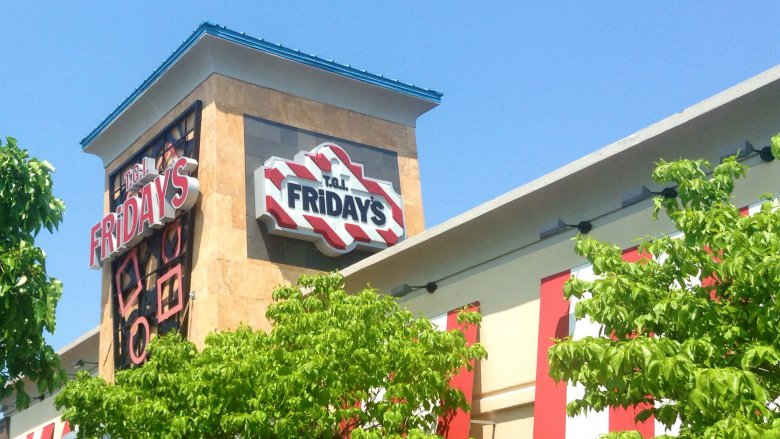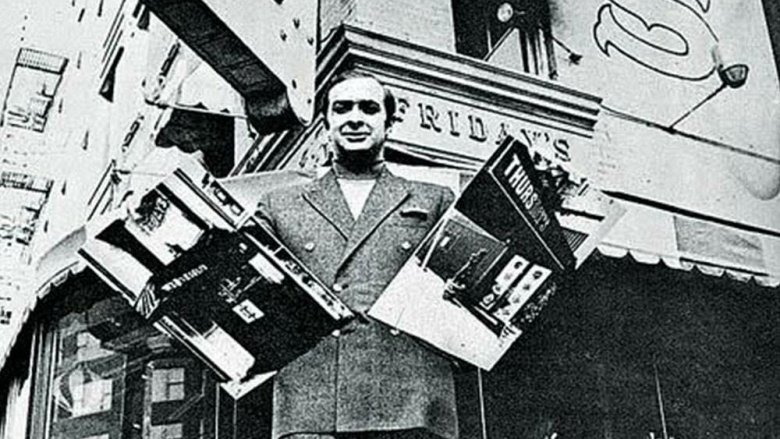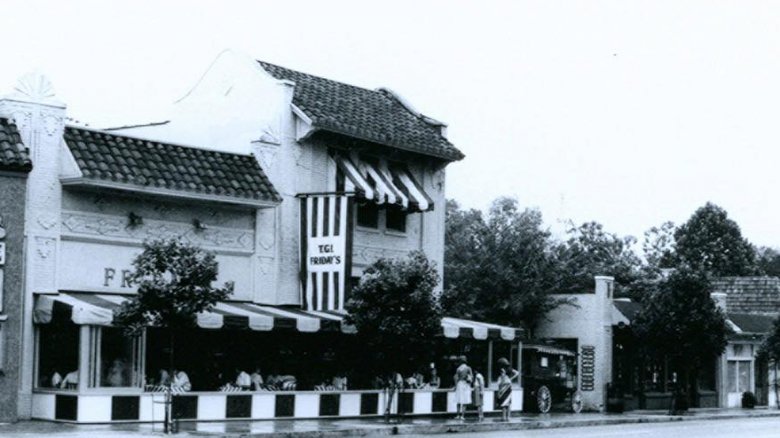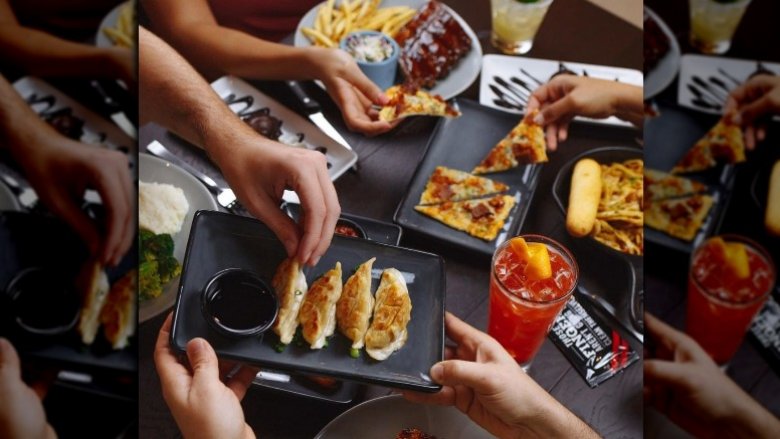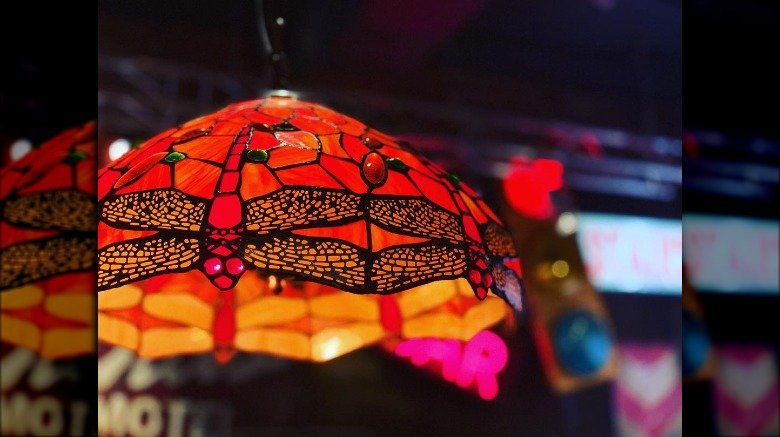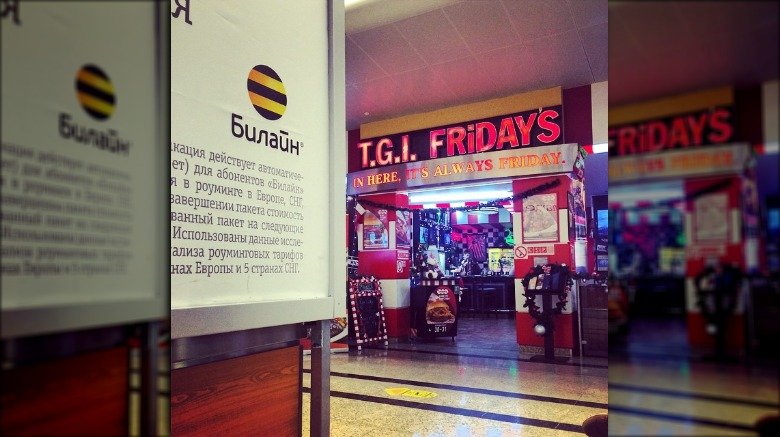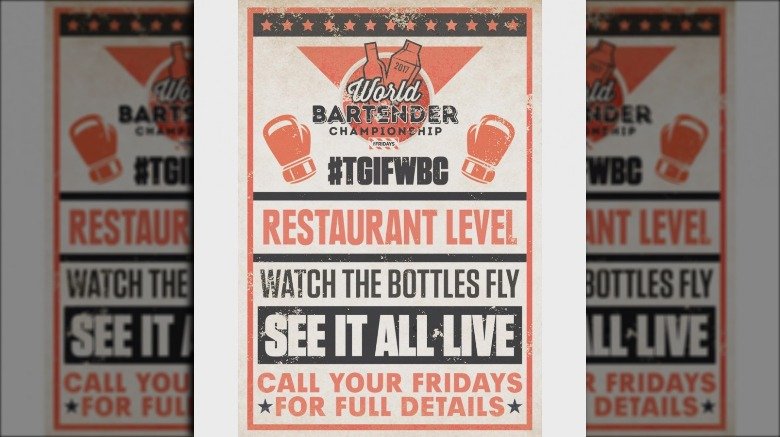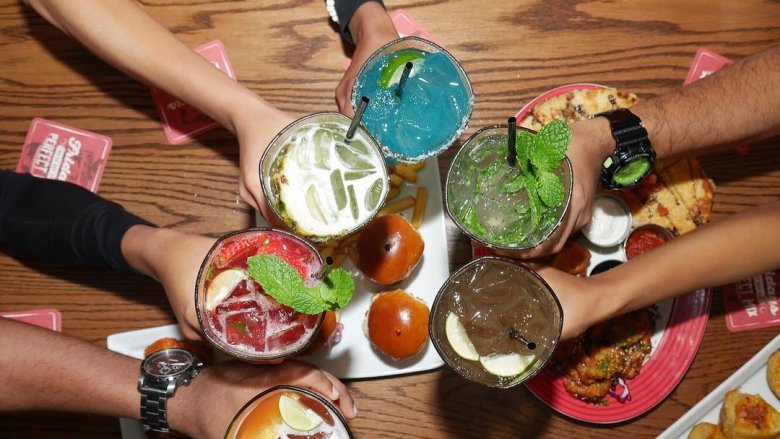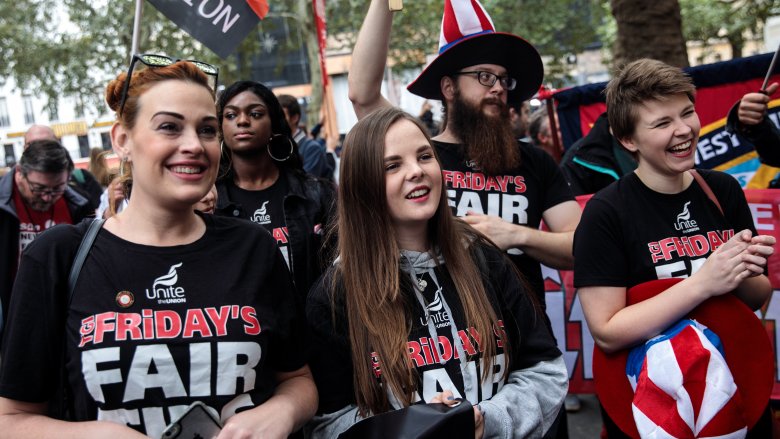The Untold Truth Of TGI Fridays
TGI Fridays is one of America's most iconic casual dining chains. Anyone who knows anything about eating out in the western world could probably reel off a detailed description of the chain's restaurants — and their defining characteristics — from the moment you said its name. You've got your cluttered, classic Americana interior decor. You've got your legendary red-and-white color scheme. And, of course, you've got your long menu of comfort foods, snacks and cocktails.
Although it may not carry quite the same brand recognition as some fast food chains have managed to acquire for themselves, TGI Fridays still ranks among the country's most famous restaurants — and its most successful exports, having opened over 900 restaurants in as many as 60 countries worldwide. And from its strange beginnings, to its historic inventions, to the innovations which are defining its future, these are some of the hidden details behind the story of America's first real family restaurant.
Its raucous beginnings
Fridays may be known today as a family-friendly casual dining establishment, but it began as anything but. In fact, it was first founded in 1965 as a singles bar, opened by Alan Stillman in an attempt to meet girls in Manhattan. It was one of the first drinking establishments to allow co-ed mingling and soon became deeply popular among the locals. The bar's early nights were pretty much just cocktail parties, with a young clientele who were particularly enthusiastic because (as Stillman himself theorizes) it appeared on the scene the same year that the birth control pill was invented.
Food was served — mostly hamburgers and fries — and the waiters were given that iconic red-and-white to wear. Otherwise, however, the bar would have been unrecognizable from Fridays today, instead aiming for a feel that its visitors were "going to someone's apartment for a cocktail party." The bar became something of a legend in New York, and soon attracted considerable media attention. Another singles bar, Maxwell's Plum, then opened up across the road, and the dating scene in America was forever changed.
The Memphis party
In 1969, an entrepreneur from Memphis named James Robinson visited Stillman's bar on a trip to New York City, and so fell so in love with it that he convinced Stillman to allow him to open a second location in his hometown. The Memphis branch of TGI Fridays became a hub for the city's youth, and soon garnered a reputation for its boozy parties, heavy drug use, and support for the city's burgeoning queer scene. In many ways, the establishment of the restaurant in New York and its Memphis sister had, according to an article in American Heritage, "began the commercialization of sexual freedom."
Before the bar opened, drinkers in Memphis had to bring their own bottles to bars, where they could then have drinks made from them by the bartenders. TGI Friday's, however, sold mixed drinks ready-made. Unsurprisingly, for this reason it was a smash success. Robinson himself went on to open more branches, in Nashville and Arkansas, and the chain's name began to spread. The rest is history.
Going legit
But TGI Fridays' days as a hip, swinging singles bar were not to last. As the early franchises became more and more popular, they began to expand into larger suburban towns across the south of America. According to Stillman himself: "Those cities have a very different way of interacting with the street in the first place, but the big shift was that during the day, we started to get families. We had very informal, casual food — you could get an omelette or a hamburger — so families were coming in with their kids. That was the big change."
The shift towards family-oriented dining didn't exactly come overnight. In fact, Stillman believes it took six or seven years for TGI Fridays to become more or less what it is today. And in 1971, he was approached by a potential buyer for the chain and offered him a significant amount of money to sell. Stillman, enticed by the size of the offer and anxious about the state of the economy, sold. TGI Fridays became a corporate entity. Today, the bar's raucous party days seem like nothing more than a distant memory.
Sourcing the clutter
One of the more memorable aspects of TGI Fridays' personality is the trademark clutter that fills each of its restaurants. You know exactly what we mean: it's that timeless, bizarre heap of antiques and memorabilia that practically makes TGI Fridays what it is. And while this choice of design gives each restaurant its own distinct personality and character, the fact is that this clutter is gathered in a far more regimented fashion than you might expect.
The clutter comes from a 25,000 square foot warehouse located in Nashville, Tennessee, with about a quarter of its items made specially for use by TGI Friday's. The rest are actual antiques, discovered and commandeered by the company via its own team of "pickers," who acquire them from flea markets and sales. There are only two items which are found in every single TGI Fridays: an airplane propeller over the bar and a racing scull. The first is to remind employees that the bar is what drives the restaurant forward, while the scull is to remind them of the importance of teamwork.
As played by Tom Cruise
Roger Donaldson's 1988 rom-com Cocktail was one of the films that helped put Tom Cruise on the map. Based on a semi-autobiographical book of the same name by Heywood Gould, it tells the story of a business student in New York City who takes up bartending to pay the bills. Despite a devastatingly poor critical reception, Cocktail enjoyed considerable box office success upon its release and has become something of a cult classic by way of just how bad it really is.
Here's where TGI Fridays comes into this. The restaurant's founder, Alan Stillman, insists that (despite the film's autobiographical nature) Tom Cruise's character — who utilizes the same kind of flair bartending for which Stillman's chain was known — is based on him. According to Gothamist, Stillman said: "Have you seen the movie Cocktail? Tom Cruise played me! Why do girls want to date the bartender? To this day, I'm not sure that I get it."
Parting the Iron Curtain
During the 1990s, Russia was just beginning to find its place in a post-Soviet world. Although the USSR had dissolved and the new federation promised a more liberal, globally-linked future than it had once imagined possible, the notion of American corporations setting up on Russian soil was still a strange one. It's here that TGI Fridays proved to be something of a pioneer — in 1997, it became the first American casual dining restaurant to open in Moscow.
Since the turn of the millennium, TGI Fridays has only become more ubiquitous in both the West and the East, and, today, the chain has fourteen restaurants in and around Moscow. Whether that stands as testament to the easing up of hostilities towards the West on the part of the Russian people, whether it's a reminder of the incredible omnipresence of American culture, or whether it's just proof that people like burgers and cocktails, no matter where they're from — well, we'll leave that up to you.
They may have invented your favorite appetizer
Loaded potato skins are a mainstay item on pretty much every TGI Fridays menu. Arguably, it's even the most well-known appetizer the restaurant offers, and, to many, potato skins are practically synonymous with the TGI Fridays name. This all becomes pretty unsurprising, however, once you discover that Fridays lays claim to having invented the dish in the first place, as far back as 1974.
That claim, however, is contested. The Prime Rib Restaurant in Washington D.C. and R.J. Grunts in Chicago both also believe themselves to have been the birthplace of the loaded potato skin, with the latter insisting that the recipe came from stories of sailors eating them to ward off illnesses while at sea. No definitive answer to the question of the origins of potato skins seems to exist, but if TGI Fridays really wants to have their claim taking seriously — well, they probably want to get themselves a story, too.
A flair for drinks
In case you needed any further convincing that TGI Fridays takes its bartending really, really seriously, you've got their Annual World Bartender Championship, which has now been running for almost three decades. Nine finalists compete in Dallas for a grand prize of $10,000, each attempting to show off their flair bartending skills.
The competition began in 1991, but has its origins in the mid-80s, when a staff member in California began his own in-store bartending competition and pretty much started the art of flair bartending. Nowadays, the contest consists of a written test, a speed test and an accuracy test, with competitors expected to memorize the chain's list of 500 cocktails. Much of the competition takes place in a role-play environment, with judges acting as mock patrons. So it's pretty full-on. But what else would you expect from the company that once petitioned the Olympics to get bartending admitted as an official sport?
Attack of the drones
Much like a number of other dining and fast food chains across America, TGI Fridays' future is one driven by technology. Part of their flirtation with the tech world came in 2014, when the restaurant began using drones to deliver mistletoe to customers' tables. The concept is pretty simple: You go into your local branch of Fridays and sit down at the table. At some point during the meal, a flying robot carrying a branch of mistletoe appears over your head. If you comply with its silent demand, it'll take a photo of you and your partner kissing and project it onto a large screen set up inside the restaurant.
So, yeah — "horrifying" doesn't begin to cut it. And that's before you count in the drone-on-face collision that was reported in the weeks following the drones' roll-out. A photographer for the Brooklyn Daily had one drone attempt to land on her hand, and instead slice off a part of her nose and cut her under the chin.
TGI gets a little help from AI
If you thought the whole drones thing was bad enough, just wait until you see who TGI Fridays has been trusting with control of its business plans: Skynet. Okay, so Fridays isn't exactly run by a malignant hive-mind located inside a sentient supercomputer (yet) but A.I. does constitute a vital part of the wider company. It comes in many forms for the chain: algorithms are used to help managers order ingredients, deal with waste, schedule staff, and identify cases of fraud.
Micro-targeting is also used on an experimental basis, with frequent customers able to be identified by their phones, allowing staff to greet them by name and offer them their regular cocktails. Meanwhile, data farming anyone who joins a restaurant's Wi-Fi means that branch can suggest to users within a certain radius that they stop by for a bite. It's all very interesting, very impressive and very, very scary.
Striking back
Like many large corporations, TGI Fridays has often found itself on the receiving end of industrial action as a result of abuses made against its employees. In 2018, for example, the chain's U.K. outlets suffered a series of strikes imposed by its workers. The first strikes, in May, came after Fridays implemented a new pay policy which redistributes customer tips from waiters to kitchen staff, a change that was expected to cost servers hundreds of pounds every month. Union representatives insisted that this was a result of "greedy" owners who refused to pay their workers "anything above the bare minimum."
The second round of strikes came in September, as part of a coordinated action planned by workers at JD Wetherspoon, McDonald's and TGI Fridays. This time, employees of the chain demanded a pay deal of £10 (about $13) per hour. It occurred as part of an international day of action organized by fast-food workers across the world.
